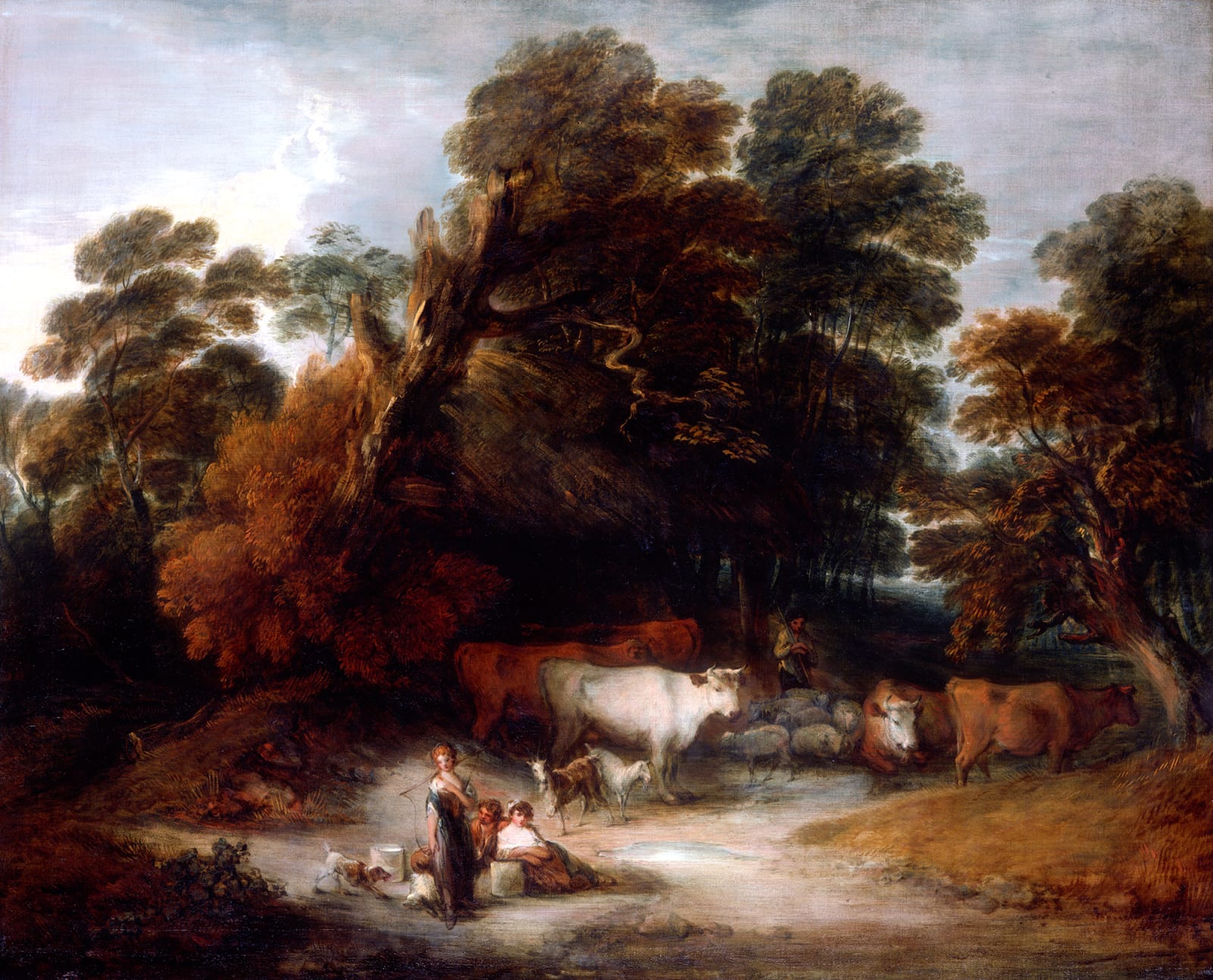
Thomas Gainsborough RA
To view all current artworks for sale visit philipmould.com
We are grateful to Dr John Hayes for confirming the attribution to Thomas Gainsborough.
Gainsborough’s lyrical vision of landscape in all its scope and subtlety is exemplified by this exquisite landscape. In this large canvas the patient study of the old masters, of the pastorals of Rubens of Wynants, that underpins the development of the Bath period landscapes is brought to a magnificent fruition. The result is a monumental work rich in atmosphere and animated by an implicit narrative; the painter’s inspirations have been thoroughly digested and coloured by his very personal conception of the English landscape to produce a work which at the time of its execution and now speaks with nostalgia of a pastoral idyll, even if it is one which may never have existed.
Gainsborough’s landscapes draw on both the fantasies of Poussin and Claude and the reality of the mid-Georgian countryside with which he was so familiar and in which he could immerse himself during his years in Bath. He would have endorsed the remarks of Benjamin West writing some forty years later, who felt that ‘there is not in the world anything superior to [the countryside around Bath]. Rocks of the finest forms for a painter that He had ever seen … Cliffs most picturesque – distances the most beautiful – roads with occasional pools and streams of water falling from the Hills & Cattle & figures such as Berghem never saw.’ 1
Gainsborough brought his knowledge and appreciation of painters such as Nicolas Berchem to his personal experience of this remarkable countryside. The present landscape includes near-quotation from Berchem – the cowherd in the middle distance resembles figures by Berchem, and the cows in their drawing and scale also reveal a debt to the Dutch master. The overriding influence by this date in Gainsborough’s Bath landscapes, however, is Rubens. This painting antedates Gainsborough’s most explicit homage to the Flemish master, The Watering Place (National Gallery, London) of 1777, but in the rich depths of the woodland, and in the carefully crafted recessions, and above all in the colouring it recalls the landscapes that Rubens painted of the country around his estate at Het Steen. The comparison is a particularly valid one, since Rubens like Gainsborough was both a theorist and student of painting and a lover of the countryside. He felt deep affection for Het Steen in the manner that Gainsborough drew inspiration and creative energy from the landscape that he loved. The elements that are so satisfying in the present landscape, the plausible milkmaids and the rustic lovers who – as always in Gainsborough – appear to be portraits of English rustics rather than genre archetypes, appeal because of their convincing reality. This is unsurprising, since Gainsborough is known to have taken country people as his model and to have reproduced them with relative fidelity. This fidelity to his subject extended even to the branches of the trees. The sinuous tree-limb that extends out into the picture plane from the foliage at the left is a form familiar from other landscapes of this period – early versions of the Cottage Door theme, for example – and no doubt it was one of ‘the limbs of trees which he collected, [which] would have made no inconsiderable wood-rick.’2 Reynolds recognised this preoccupation with reality – quite different from his own method – and remarked his ‘portrait-like representation of nature, such as we see in the works of Rubens, Ruysdaal and others of those Schools.’3
As with several of Gainsborough’s most harmonious and poetically satisfying large – scale landscapes the present composition exists in more than one version. The painting in the collection of the Taft Museum Cincinatti, Ohio (Hayes 1982 no.112) repeats the composition with minor variations, chiefly the addition of a large milkpail which the girl in the foreground group is supporting on her head, and the omission of the prominent tree-limb to the left. Upon inspection of the present painting Dr John Hayes supported the earlier judgment of Professor Ellis Waterhouse that it is ‘Possibly a little earlier than the other two,’4 referring in this instance to the Taft painting and a version in the Cincinnati Museum of Fine Arts. The latter painting was accepted with reserve by Waterhouse (‘perhaps also an original’) and Hayes recognises that this, with its more garish colouring and perfunctory drawing is the work of Gainsborough Dupont.
1. George Farington Diary, 1807, quoted in John Hayes, The Landscape Paintings of Thomas Gainsborough, New York, 1982, Vol. I, p. 94.
2. William Jackson, The Four Ages, London, 1798, p. 168, quoted ibid.
3. Sir Joshua Reynolds Discourses on Art San Marino, 1959, quoted ibid.
4. Waterhouse Gainsborough, 1954, p. 114.
Provenance
Hon. Augustus Phipps Collection;His sale, 19th April 1834 (lot 3), bought by Sir Eyre Coote Bt;
Coote Collection, Ballyfin, until c. 1914;
Anonymous sale, 26th June 1914 (lot 75), bought by Amor;
Reputedly Buenos Aires Private Collection;
French Private Collection, until December 2004
Literature
Ellis Waterhouse, Gainsborough, 1954, p. 115, no. 921;John Hayes, The Landscape Paintings of Thomas Gainsborough, New York, 1982, Vol. II, p. 459, 581